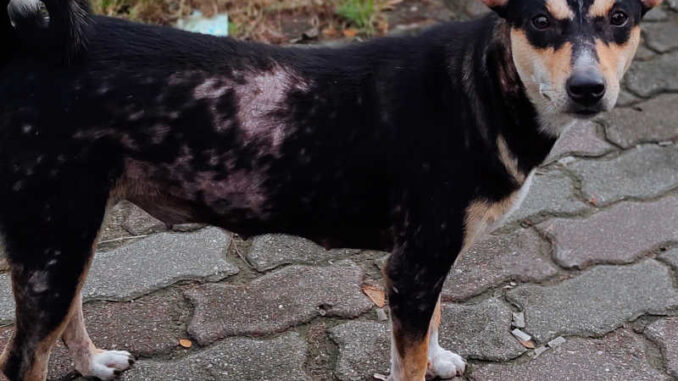
This article was updated on September 28th, 2023
Folliculitis, also known as superficial pyoderma, is a very common skin condition in dogs. In a typical week, my veterinary practice will see anywhere between five and 15 cases. Being able to recognize that your dog has folliculitis can be helpful in getting them needed treatment.
Symptoms of folliculitis in dogs
Bacterial infections often cause inflammation of the hair follicle, which is known as folliculitis. Folliculitis (bacterial) can lead to:
- The build-up of crusts (scabs form),
- Small bumps (papules),
- Raised hairs (tufted papules) and
- hair loss.
Pictures of folliculitis in dogs:
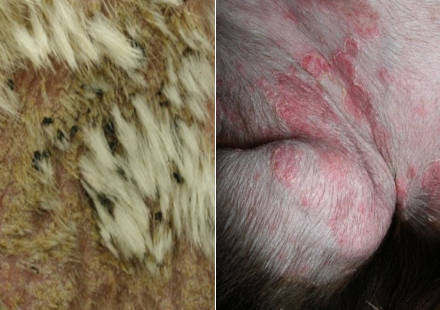
The follicles become inflamed, and the surrounding skin becomes scaly. Dogs affected with folliculitis will often have lesions in areas where the fur is thinnest, and the overall coat quality may be dull and poor.
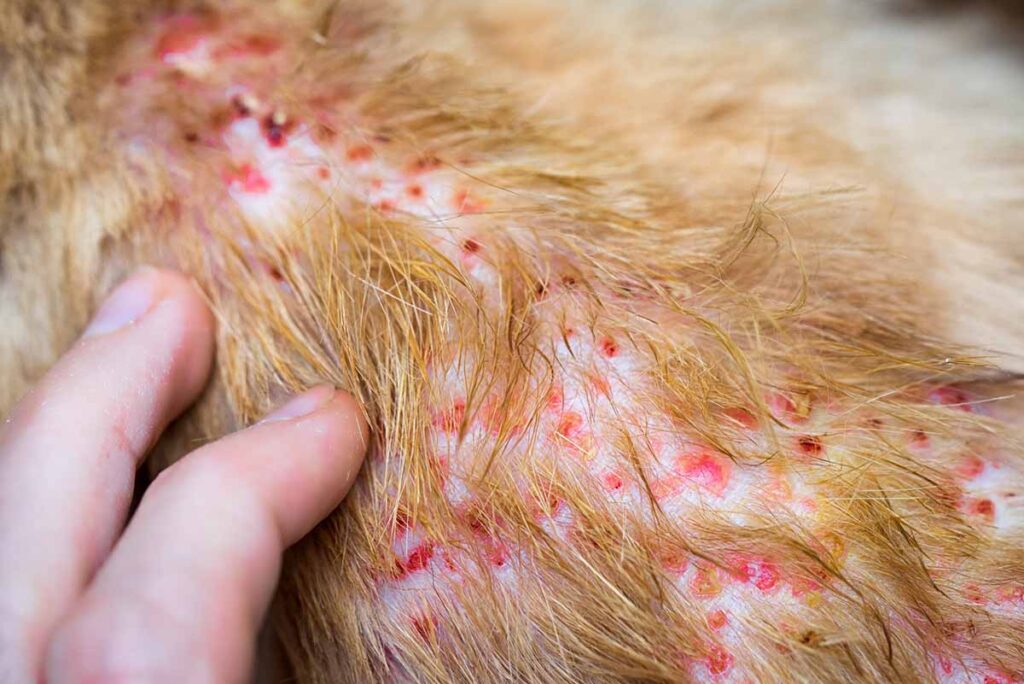
In time, the affected skin may become:
- pigmented (hyperpigmented),
- thickened (lichenified) and
- sometimes malodorous.
When a fair follicle ruptures and there is a deeper infection, it is known as furunculosis.
What folliculitis looks like in dogs [8 more pictures]
Folliculitis in dogs is most commonly the result of a bacterial infection of the hair follicles. The most common bacteria involved with this condition are staphylococcal bacteria.
Picture 1: Patchy hair loss in a dog as a result of folliculitis:
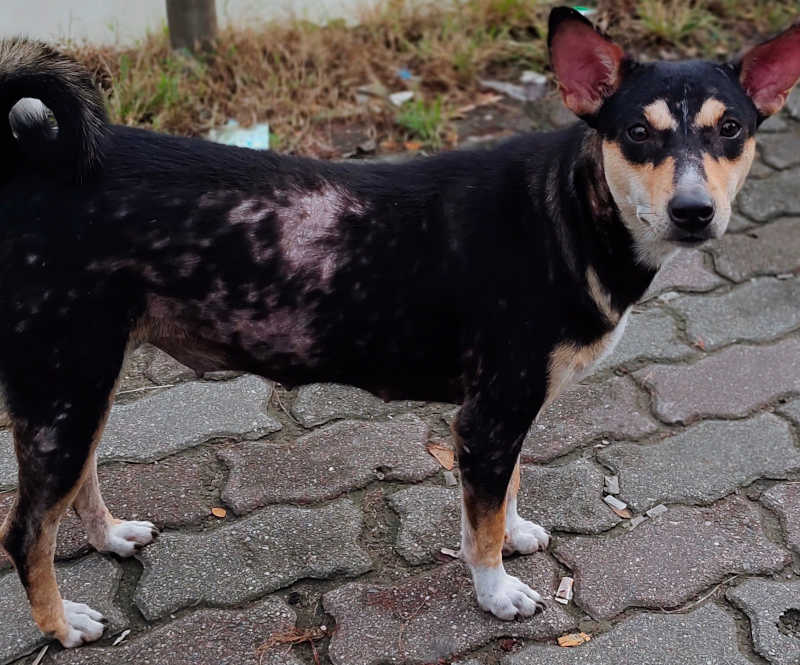
Pictures 2 & 3: Patchy hair loss as a result of the disease:
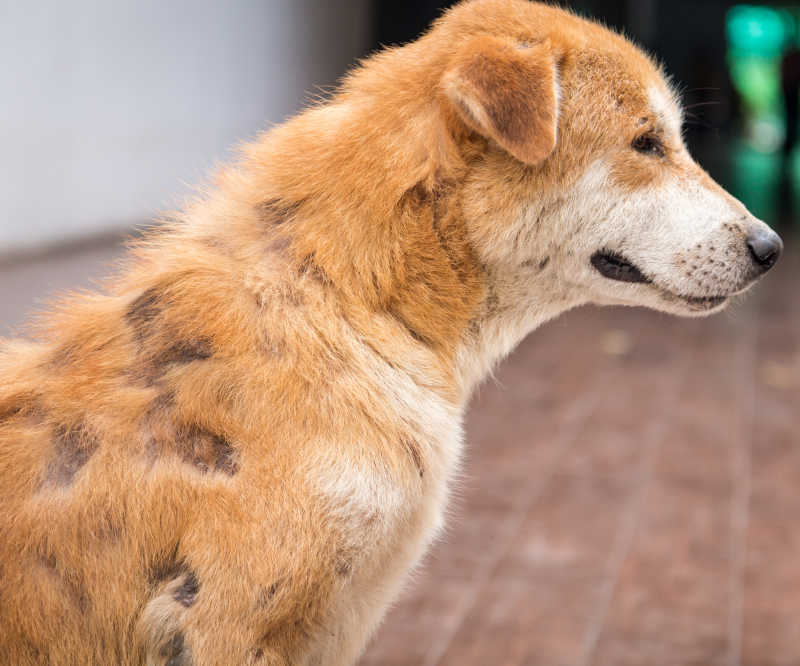
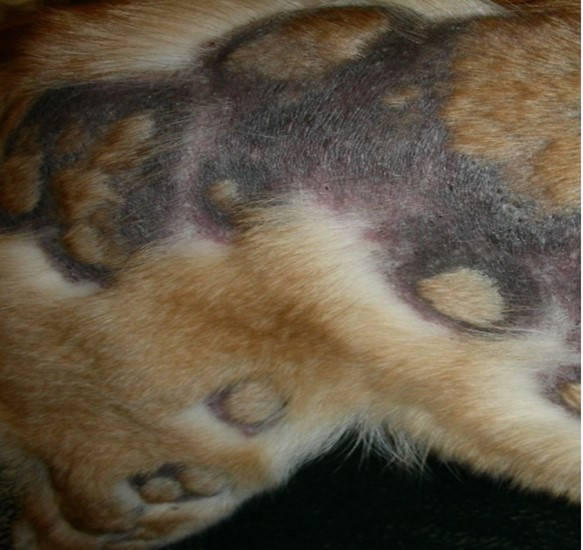
Picture 4: Bulldog with allergic folliculitis
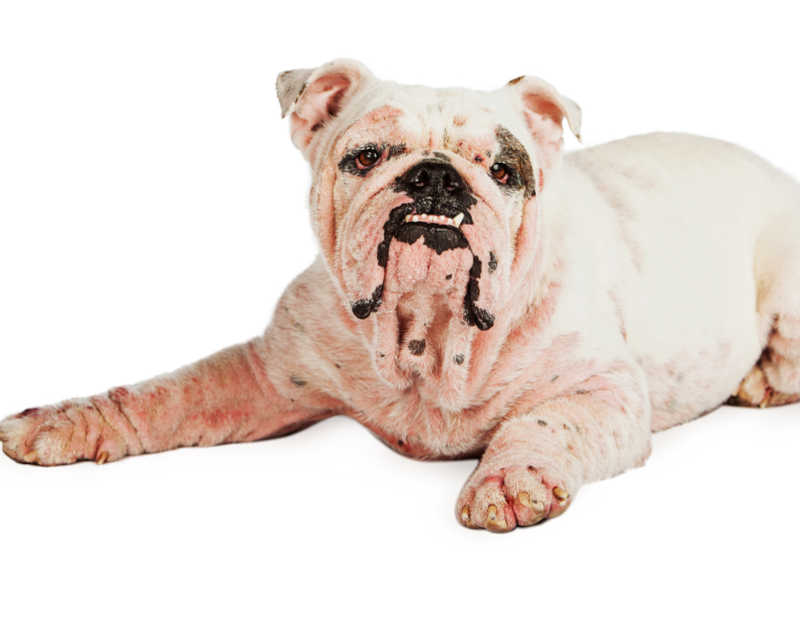
Picture 5: Here is a more severe case of widespread folliculitis in a dog:
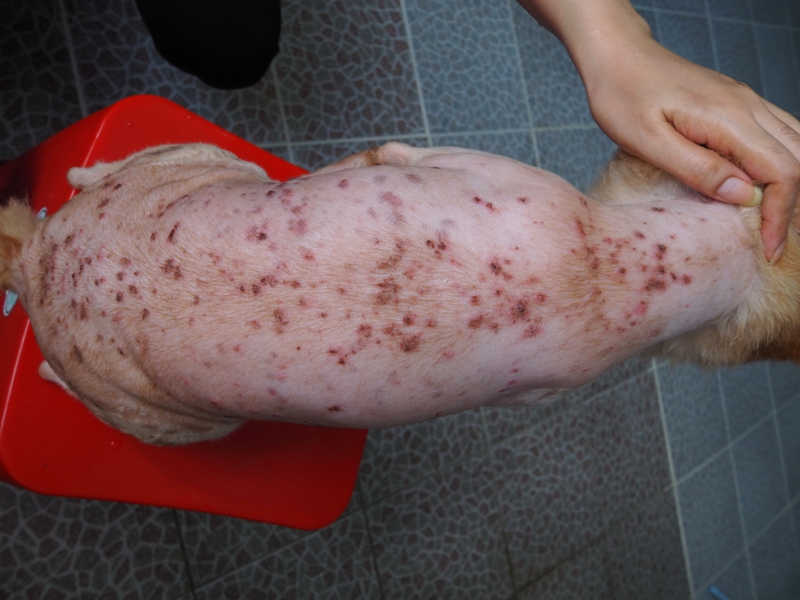
Picture 6 – 7 – 8: Up close pictures of folliculitis in a dog:
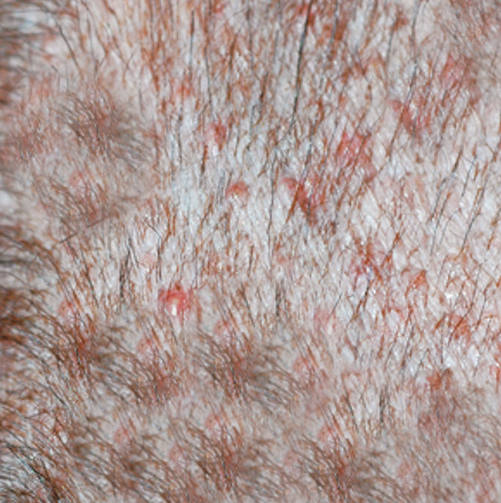
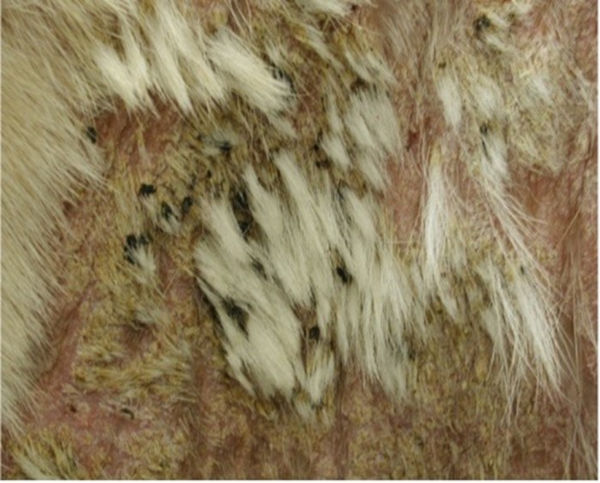
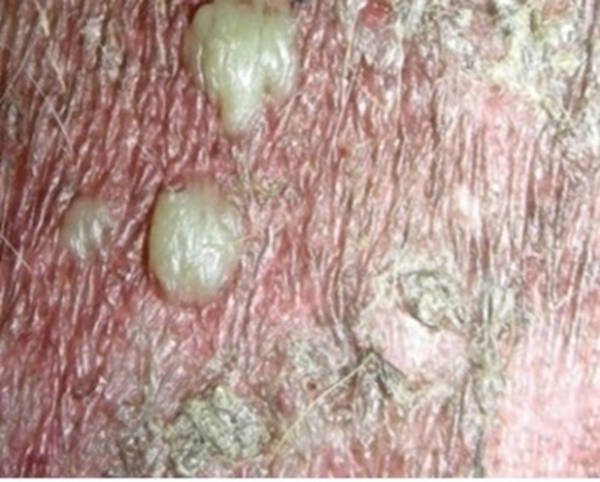
Two pictures above: © Ian Brett Spiegel VMD, MHS, DACVD
Common symptoms include pustules, papules, red skin, swelling, hair loss and itching
You will find below pictures representing typical visual characteristics of folliculitis in dogs, including: pustules, papules, redness, swelling, hair loss, itching, licking, scratching, or dark areas/pigmentation.
1. Pustules
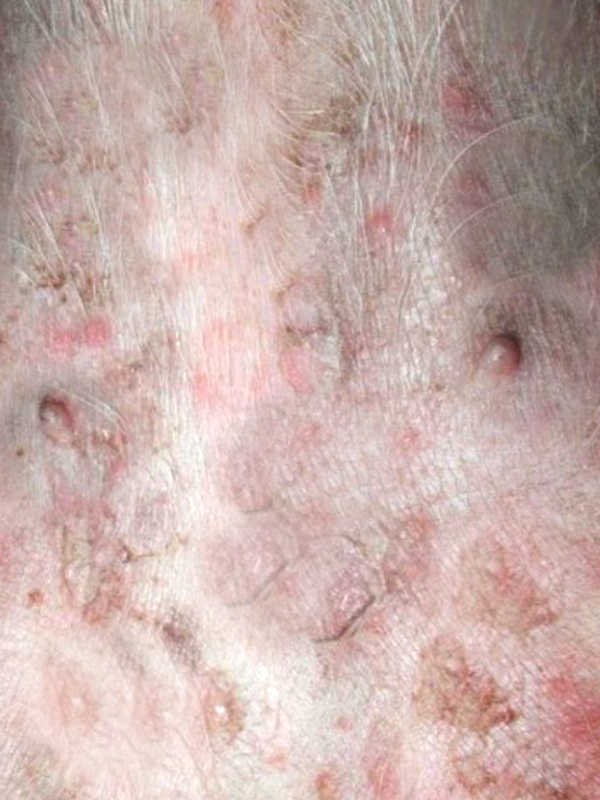
2. Papules

3. Redness
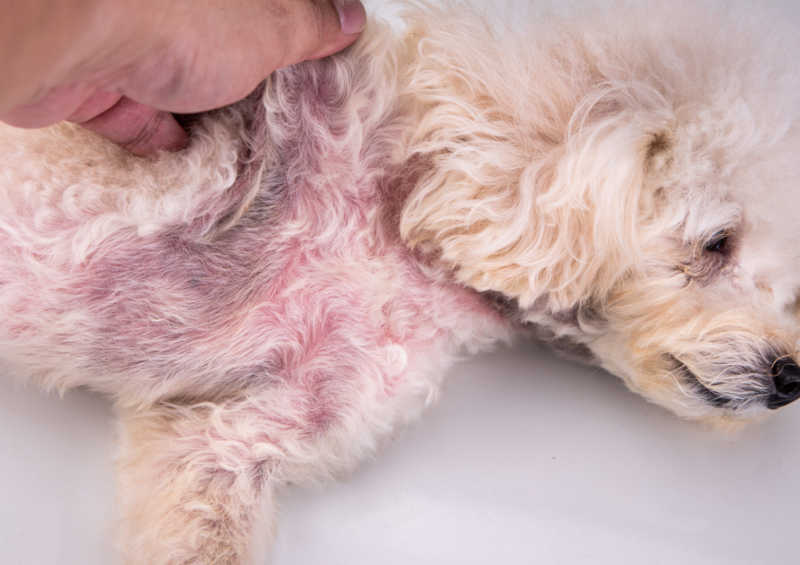
4. Swelling
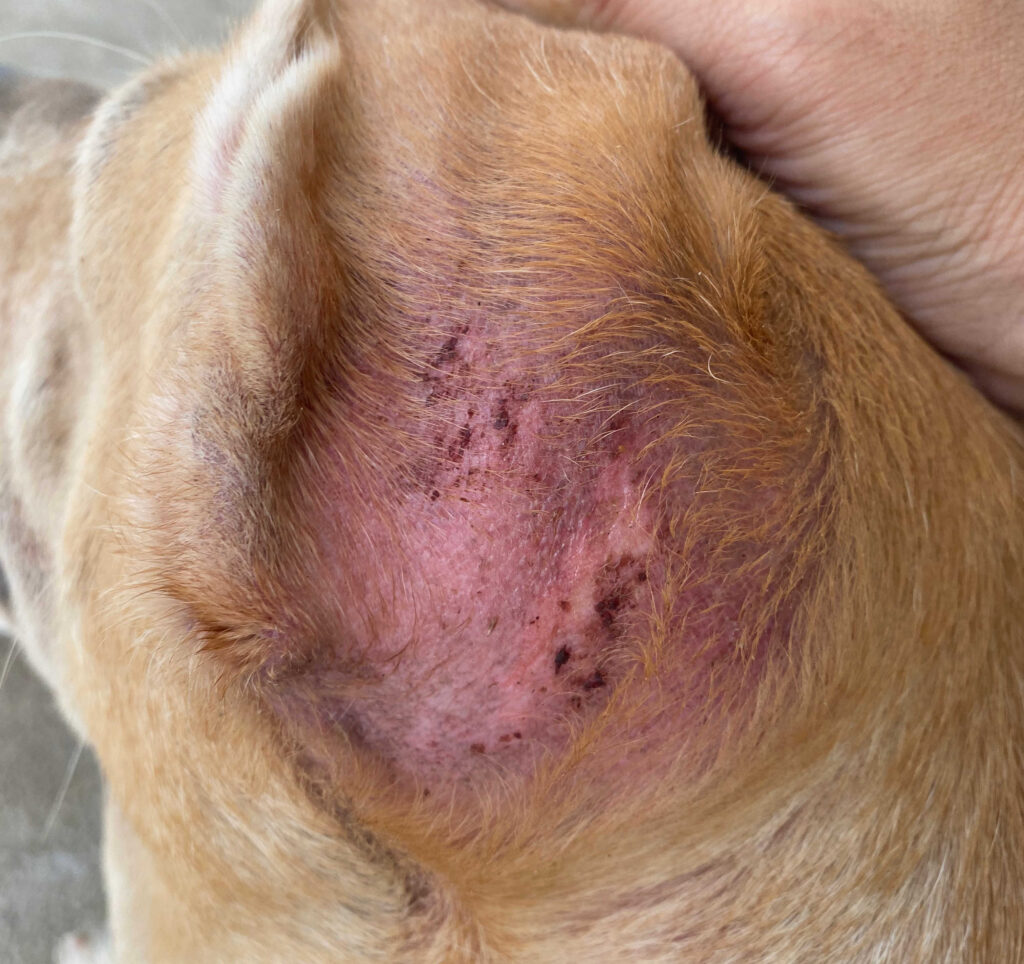
5. Hair loss.
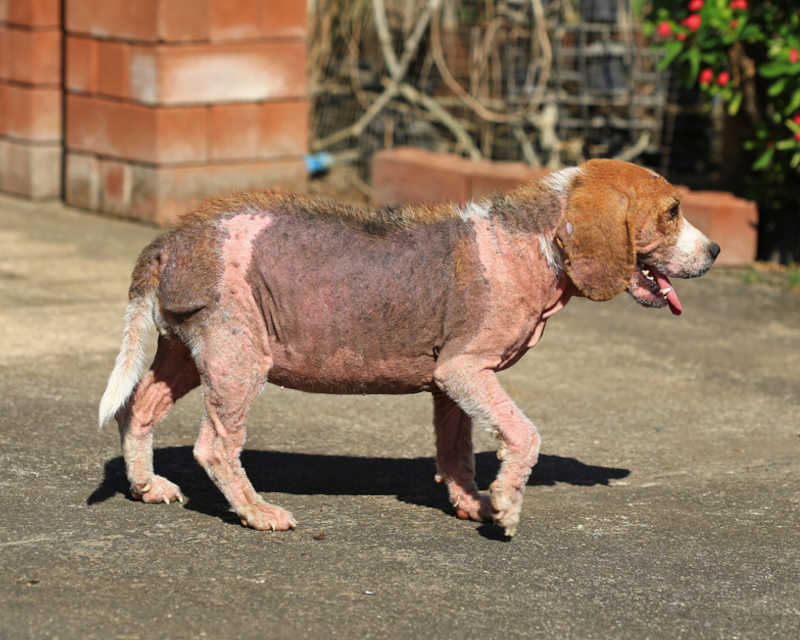
6. Itching, licking or scratching.

7. Dark areas / pigmentation.
Read more with our article about dark spots on dog skin.
Folliculitis can be primary or secondary
- Primary: If the condition is primary, then the issue is simply an overgrowth of bacteria, and the skin is otherwise healthy. There is no underlying condition causing the folliculitis. An appropriately selected antibiotic, whether topical or oral, will clear things up.
- Secondary: The other type of folliculitis, secondary, results due to an underlying issue that is compromising the skin. The most common issue is allergies. Though these dogs may also require oral or topical antibiotics, treatment will not be successful without addressing the underlying condition.
There are many underlying causes of folliculitis, including allergies, mange, infections, and trauma
“The underlying reasons can vary widely: Allergies are the most common culprit. Fleas, mange parasites, fungal infections, as well as systemic diseases such as autoimmune disorders, endocrine issues, and trauma can all result in folliculitis.”
1. Flea allergy dermatitis
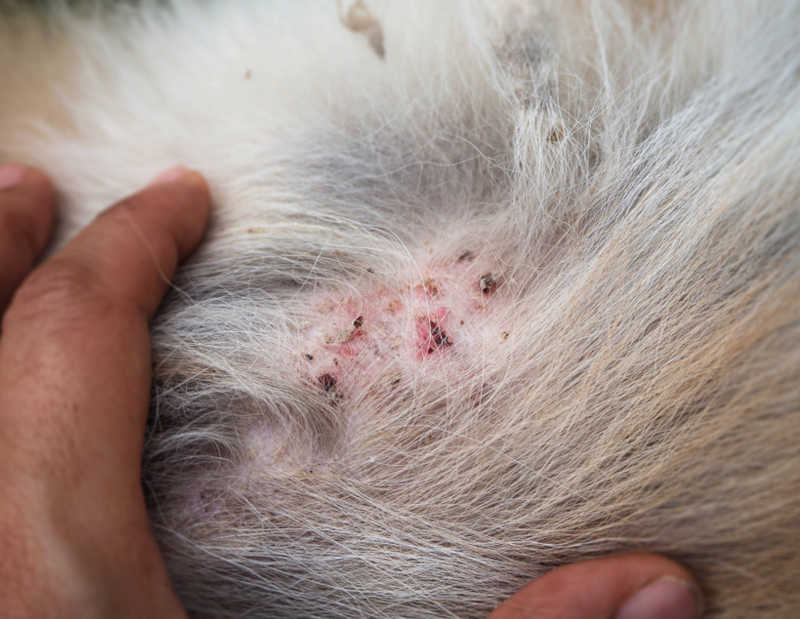
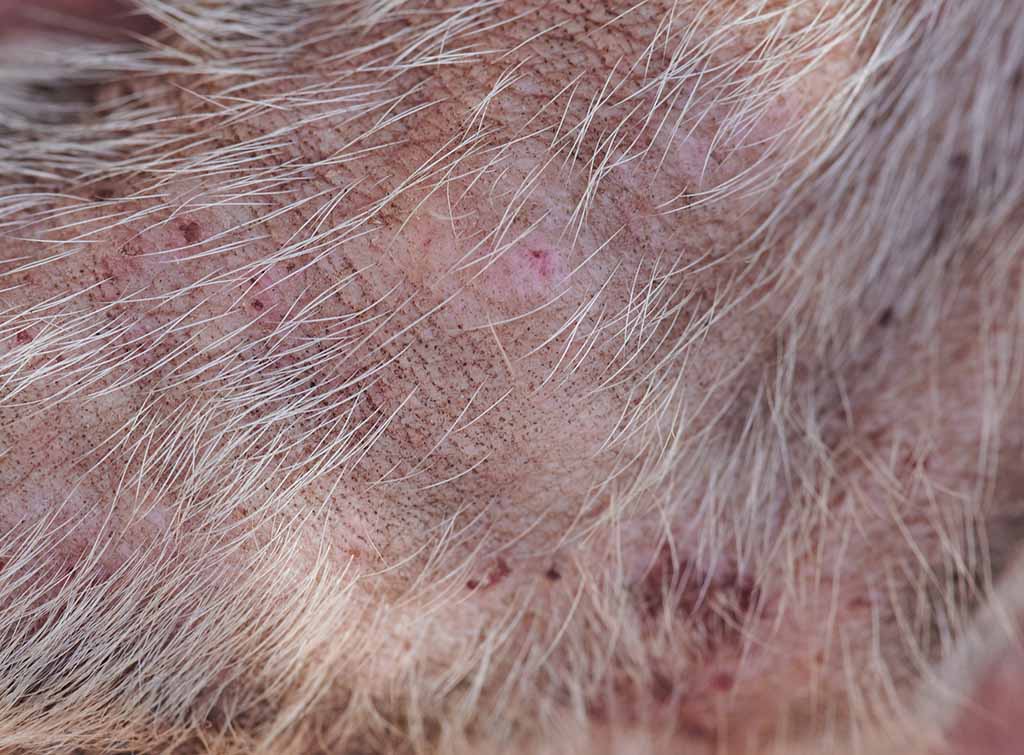
2. Sarcoptic mange
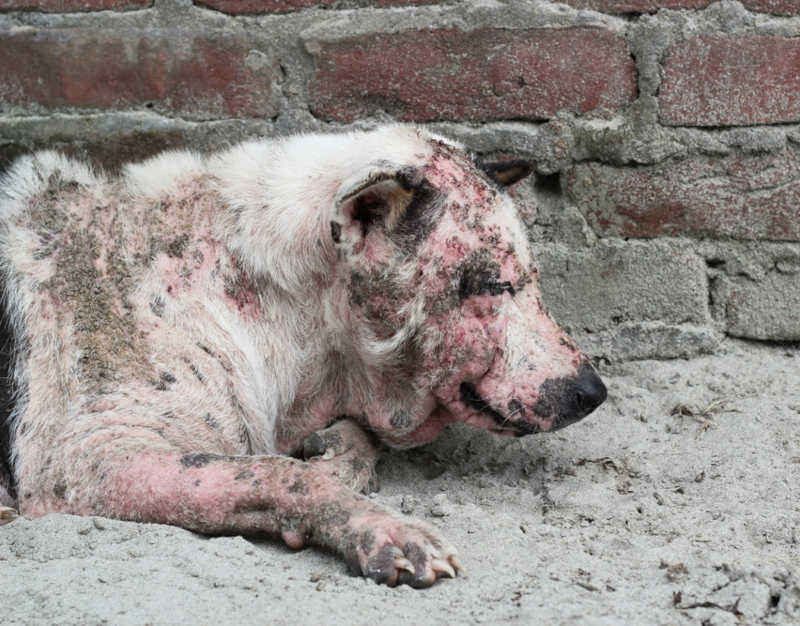
3. Demodectic mange
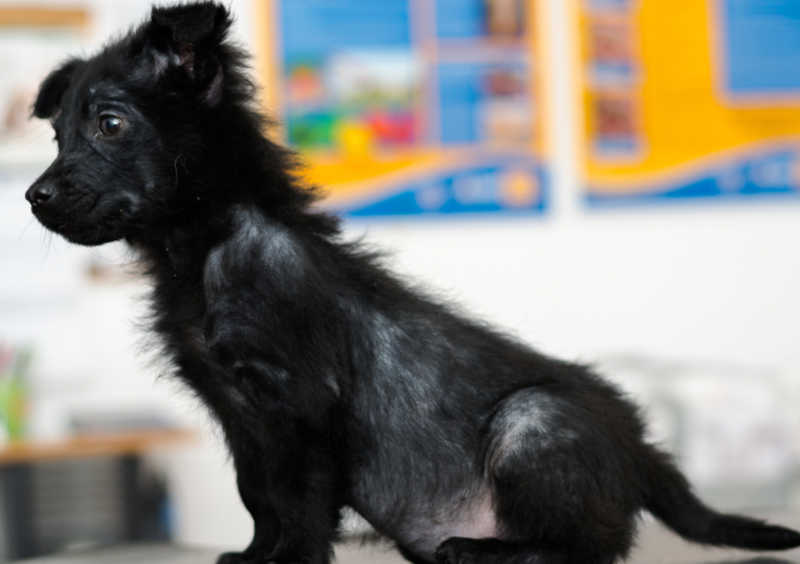
4. Skin allergies
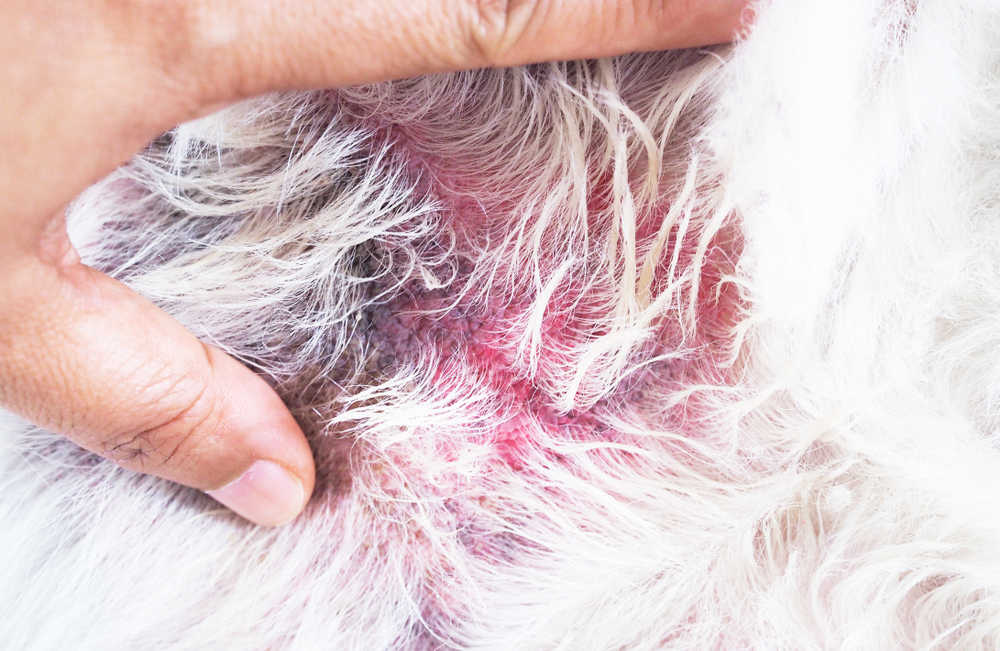
5. Irritation or trauma
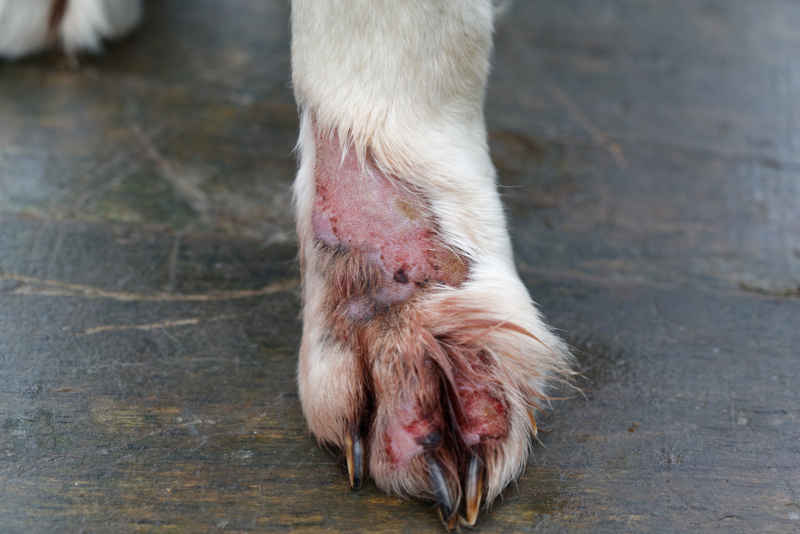
Treatment
Folliculitis is treated with antibiotics and antibacterial shampoos. The underlying reason for the infection will also need to be addressed to prevent a recurrence.
“There are no effective home remedies, but a bath with oatmeal shampoo might help sooth the skin”
There are no effective home remedies for this condition, and an accurate diagnosis is essential for effective treatment. After you make an appointment for your dog, you can try:
- Soothing their skin while waiting with a bath using oatmeal shampoo and cool water.
- Keeping the dog indoors and cool may also help.
- You should remove any collars, clothing, or harnesses to eliminate irritation from those items.
- Scratching, licking, and biting the area should be gently discouraged. An Elizabethan collar may be needed.
Treatment often involves prescription medications, such as antibiotics, antiparasitics, and antifungals
Usually, folliculitis requires prescription medications, such as antibiotics, antiparasitics, and antifungals for treatment. Depending on the cause, these may be topical, systemic, or both.
When to call your veterinarian
If your dog’s skin is red, irritated, swollen, has pustules or papules, or is itchy, it is time to make an appointment with the veterinarian.
Veterinary treatment, costs & recovery
Treatment of folliculitis in dogs depends on the cause. Simple, primary folliculitis may just require some form of antibiotics, either topical or systemic. However, most cases of folliculitis in dogs result from an underlying issue. Both the folliculitis and the underlying condition must be addressed. The first step is an accurate diagnosis which your veterinarian will obtain via a thorough review of your dog’s history and environment, a complete physical exam, skin tests such as scrapings, tape preps, and biopsies, and other testing to determine underlying causes. Depending on the needed diagnostics and treatments, taking care of folliculitis in dogs will vary widely when it comes to cost.
Prevention
The most critical step to preventing folliculitis in the future is to address the underlying cause. For many dogs, this cause is allergies. Just as in humans, allergies cannot be cured, but can be managed. Environmental and food triggers can be mitigated, and there is a myriad of allergy control medications. Other causes, such as endocrine disease, will need to be closely controlled as well, typically through medication.
Frequently asked questions
Is folliculitis contagious from dog to dog or from dog to human?
In most cases, no. However, some fungal agents, fleas, and sarcoptic mange are all zoonotic, meaning they can transfer between people and animals.
Can food allergies cause folliculitis in dogs?
Yes, a food allergy may result in folliculitis in dogs. You should speak to your veterinarian about the possibility of food allergy. The most common food allergens in dogs and beef and dairy.
How long does it take folliculitis to go away in dogs?
The length of treatment required to clear folliculitis in dogs will depend on the cause and the severity. Typically, once appropriate treatment is instituted and the underlying causes, if any, are controlled, the dog should feel better in a matter of days to weeks.
Is it more common in some dog breeds?
Folliculitis is more common in dogs that are prone to allergies. These include Chinese Shar-Peis, Wirehaired Fox Terriers, Golden Retrievers, Dalmatians, Boxers, Boston Terriers, Labrador Retrievers, Lhasa Apsos, Scottish Terriers, Shih Tzus, and West Highland White Terriers1. However, any dog may develop the disease.
Disclaimer: This website's content is not a substitute for veterinary care. Always consult with your veterinarian for healthcare decisions. Read More.



My 5 lb Chihuahua has like rough spots all under her fur on her skin,I have no money to take her to a vet right now I’m gonna start asking around for help,she’s biting scratching and itching.I do have hot spot spray for that and oatmeal shampoo for dogs will that help or is there something I can do at home to help until I get her seen,I’m so very upset and sad for her this breaks my heart,My cousin had taken her to his mom’s and there was alot of fleas there and a couple of bigger dogs had been there that had skin issues and thats all i know that may have brought this on…please any suggestions
Hi there Rebecca and thanks for your question, I know it is not nice to see our dogs itchy or in discomfort.
You mention a known flea infestation, so I’d start here. If your Chihuahua has a flea allergy, they’ll be itchy (which can lead to scabs, fur loss and skin infections) until we completely eliminate the fleas.
I use Advocate spot on for those with flea allergies, though Advantage spot on can be purchased over the counter and is equally as good. They both contain the active ingredient Imidacloprid.
Once all pets are treated, we need to move on to the environment. This has to be done on the same day. While 5% of the flea burden live on the pet, the remaining 95% are in the bedding,sofas etc. We need to hot wash bedding over 60’c, hoover thoroughly and use a flea spray such as Indorex or RIP Fleas to eliminate the issue. These sprays contain an Insect Growth Regulator, so work well. Sometimes this needs to be repeated a few weeks later in case any eggs/larvae have escaped the initial cleaning.
From home, I would bathe the affected areas twice daily in a dilute Chlorhexidine (Hibiscrub) wash. You can get this from any pharmacy and it is inexpensive. You dilute it 1:10 in water and apply with cotton wool. Leave it on for 5-10 minutes, then rinse with water and pat dry.
We can limit skin damage by using a buster collar and trimming claws short, but the collar should just be short term as most dogs really dislike them.
The sooner she can see the vet the better, so we can get a diagnosis and start the best treatment plan. Most dogs with her signs would benefit from some anti itch medicine to break the itch scratch cycle and allow the skin to settle. The cost of a consultation and this medicine should not be too steep.
“The information on this website is not a substitute for in-person veterinary care. Always seek advice from your veterinarian if you have concerns about your pet’s medical condition.”
Thank you for sharing such informative pictures and insights on folliculitis in dogs! It really helps pet owners understand the condition better and know when to seek veterinary care. I appreciate the practical tips on treatment and prevention as well.
Such informative pictures! It’s really helpful to see what folliculitis looks like in dogs. The veterinarian info is also a great addition for understanding treatment options. Thank you for sharing this valuable resource!
Thank you for this informative post! The pictures really helped me understand what folliculitis looks like in dogs. My pup has been scratching a lot lately, so I’ll definitely keep an eye out for these signs. The veterinarian tips were also super helpful. I appreciate the guidance!
Great post! The pictures are really helpful in identifying folliculitis in dogs. I appreciate the veterinarian insights; they provide useful context for understanding the condition better. My dog has been scratching a lot lately, so this information is timely. Thank you for sharing!
Thank you for sharing these informative pictures and details about folliculitis in dogs! It’s really helpful to see the different stages and types of lesions, as well as the veterinarian insights. This post will definitely help pet owners recognize potential issues early. Keep up the great work!
Thank you for sharing these informative pictures! It’s really helpful to see the different presentations of folliculitis in dogs. I appreciate the veterinarian tips included – they’re useful for identifying symptoms early. Definitely bookmarking this for future reference!
Thank you for this informative post! The pictures really helped me understand what to look for in my dog’s fur. I’ve been noticing some bald spots, and now I feel more equipped to discuss it with my vet. Appreciate the veterinarian insights too!